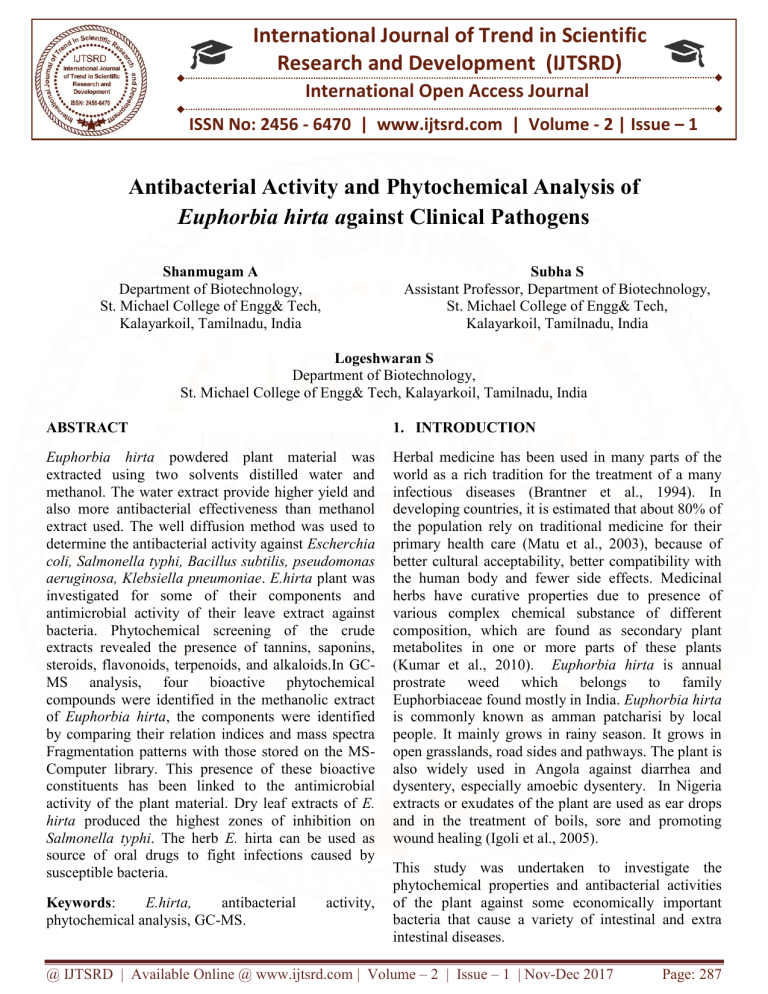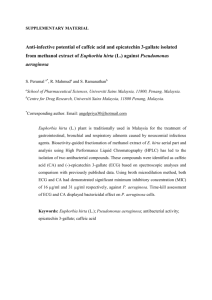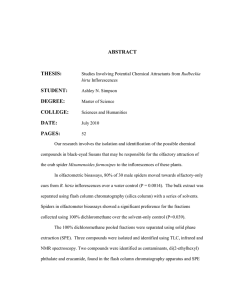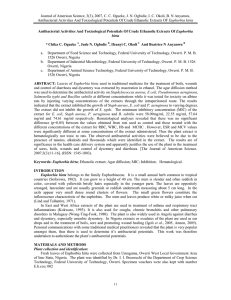
International Journal of Trend in Scientific
Research and Development (IJTSRD)
International Open Access Journal
ISSN No: 2456 - 6470 | www.ijtsrd.com | Volume - 2 | Issue – 1
Antibacterial Activity and Phytochemical Analysis of
Euphorbia hirta against Clinical Pathogens
Shanmugam A
Department of Biotechnology,
St. Michael College of Engg& Tech,
Kalayarkoil, Tamilnadu, India
Subha S
Assistant Professor, Department of Biotechnology,
St. Michael College of Engg& Tech,
Kalayarkoil, Tamilnadu, India
Logeshwaran S
Department of Biotechnology,
St. Michael College of Engg& Tech, Kalayarkoil, Tamilnadu, India
ABSTRACT
1. INTRODUCTION
Euphorbia hirta powdered plant material was
extracted using two solvents distilled water and
methanol. The water extract provide higher yield and
also more antibacterial effectiveness than methanol
extract used. The well diffusion method was used to
determine the antibacterial activity against Escherchia
coli, Salmonella typhi, Bacillus subtilis, pseudomonas
aeruginosa, Klebsiella pneumoniae. E.hirta plant was
investigated for some of their components and
antimicrobial activity of their leave extract against
bacteria. Phytochemical screening of the crude
extracts revealed the presence of tannins, saponins,
steroids, flavonoids, terpenoids, and alkaloids.In GCMS analysis, four bioactive phytochemical
compounds were identified in the methanolic extract
of Euphorbia hirta, the components were identified
by comparing their relation indices and mass spectra
Fragmentation patterns with those stored on the MSComputer library. This presence of these bioactive
constituents has been linked to the antimicrobial
activity of the plant material. Dry leaf extracts of E.
hirta produced the highest zones of inhibition on
Salmonella typhi. The herb E. hirta can be used as
source of oral drugs to fight infections caused by
susceptible bacteria.
Herbal medicine has been used in many parts of the
world as a rich tradition for the treatment of a many
infectious diseases (Brantner et al., 1994). In
developing countries, it is estimated that about 80% of
the population rely on traditional medicine for their
primary health care (Matu et al., 2003), because of
better cultural acceptability, better compatibility with
the human body and fewer side effects. Medicinal
herbs have curative properties due to presence of
various complex chemical substance of different
composition, which are found as secondary plant
metabolites in one or more parts of these plants
(Kumar et al., 2010). Euphorbia hirta is annual
prostrate weed which belongs to family
Euphorbiaceae found mostly in India. Euphorbia hirta
is commonly known as amman patcharisi by local
people. It mainly grows in rainy season. It grows in
open grasslands, road sides and pathways. The plant is
also widely used in Angola against diarrhea and
dysentery, especially amoebic dysentery. In Nigeria
extracts or exudates of the plant are used as ear drops
and in the treatment of boils, sore and promoting
wound healing (Igoli et al., 2005).
Keywords:
E.hirta,
antibacterial
phytochemical analysis, GC-MS.
activity,
This study was undertaken to investigate the
phytochemical properties and antibacterial activities
of the plant against some economically important
bacteria that cause a variety of intestinal and extra
intestinal diseases.
@ IJTSRD | Available Online @ www.ijtsrd.com | Volume – 2 | Issue – 1 | Nov-Dec 2017
Page: 287
International Journal of Trend in Scientific Research and Development (IJTSRD) ISSN: 2456-6470
2. MATERIALS AND METHODS
Collection and preparation of plant material
The fresh plant E. hirta was collected around the
surroundings of main campus of the St.Michael
college of Engineering and Technology, Kalayarkoil,
Tamilnadu state, India.The fresh plant was harvested,
rinsed with tap water and air dried under shade for 4
Fig 1:E.hirtaplant
days and reduced to coarse powder using pestle and
motar and then grinded to fine powder. The powder
was stored in an airtight bottle until needed for
use.The preparation of extract was done by
maceration method. Methanol and water used as
solvent. Extraction from fresh and dry leaves of E.
hirta was done with water and methanol.
Fig 2: Methanol Extract
Preliminary phytochemical analysis was done for the
both methanol and water extract. Test for tannins,
saponins, flavonoids, alkaloids and steroids were
done.
GC-MS analysis of the extract was performed using a
Perkin-Elmer GC Clarus 500 system. . The relative %
amount of each component was calculated by
comparing its average peak area to the total areas,
software adopted to handle mass spectra and
chromatograms was a Turbomass. Interpretation on
mass spectrum GC-MS was conducted using the
database of national Institute Standard and technology
(NIST) having more than 62,000 patterns.
Antibacterial Activity
Among
five
microorganisms
one
Gram
positiveBacillus subtilis while four Gram negative
bacteria were Escherichia coli, Salmonella typhi,
Klebsiella pneumonia, Pseudomonas aeruginosa. All
the cultures maintained on nutrient agar slants at 40ºc.
The antibacterial assay activity was performed by
agar well diffusion method. For agar well method,
about 15-20 ml Muller Hinton agar was poured into
sterilized petri plates. After solidification 0.2 ml of
broth culture of test microorganism were inoculated in
the media separately. 10 µl of test compound was
introduced into the well. The plates were incubated
overnight at 37ºC. Microbial growth was determined
Fig 3: Water Extract
by measuring the diameter of zone of inhibition. For
each bacterial strain, controls were maintained where
pure solvents used instead of the extract. The result
was obtained by measuring the zone diameter. The
experiment was done three times and the mean values
are presented.
3. RESULTS AND DISCUSSION
PHYTOCHEMICAL ANALYSIS
Preliminary phytochemical screening of the crude
extract of Euphorbia hirta showed the presence of
saponins, tannins, alkaloids, flavonoid, and steroids.
Table shows the phytochemical screening of aqueous,
methanol, of Euphorbia hirta. Qualitative screening
confirms the presence of five compounds support the
use of plant in folklore medication.
PHYTO
COMPOUNDS
Saponins
WATER
EXTRACT
+
METHANOL
EXTRACT
+
Tannins
+
+
Flavonoids
+
+
Steroids
+
+
Alkaloids
+
+
Tab 1: Phytochemical composition of water,
methanol of E.hirta
@ IJTSRD | Available Online @ www.ijtsrd.com | Volume – 2 | Issue – 1 | Nov-Dec 2017
Page: 288
International Journal of Trend in Scientific Research and Development (IJTSRD) ISSN: 2456-6470
Fig 4: Test for Saponins
Fig 5: Test for Tannins
Fig 6: Test For Steroids
A – Methanolextract, B- water extract
Fig 7: Test for Flavanoids
Fig 8: Test For Alkaloids
GC-MS ANALYSIS
The methanolic leaf extract of Euphorbia hirta was studied by GC-MS. There are 4 compounds identified using
this technique. Among these, phytol, is a major compound because it is act as a skin care agent and anticancer
agent .GC-MS chromatogram of the methanol extract of Euphorbia hirtashowed four peaks which indicated the
presence of four major phytochemical constituents. The identification of phytochemical compounds is based on
the peak area, molecular weight and molecular formula.
Sl.
No
Name of
compound
RT
(min)
Peak
% of
Molecular
Molecular
Area(%) equal Weight
Formula
1
Azulene
6.021
2.98
93
128.17
C10H8
2
2-propenoic acid,
9.038
6.20
97
148.0524
C9H8O2
3-phenyl
3
Phytol
16.441
3.28
64
296.53
C20H40O
4
Bis(2-ethylhexyl)
20.091
87.54
91
390.56
C24H38O4
Tab 2: Phytocompounds identified in the leaf methanol extract of E.hirta
@ IJTSRD | Available Online @ www.ijtsrd.com | Volume – 2 | Issue – 1 | Nov-Dec 2017
Page: 289
International Journal of Trend in Scientific Research and Development (IJTSRD) ISSN: 2456-6470
Fig 9: GC-MS chromatogram of methanolic extract of
leave of E.hirta
Fig 11: Mass spectrum of 2-propenoic acid, 3phenyl-
Fig 10: Mass spectrum of azulene
Fig 12: Mass spectrum of phytol
@ IJTSRD | Available Online @ www.ijtsrd.com | Volume – 2 | Issue – 1 | Nov-Dec 2017
Page: 290
International Journal of Trend in Scientific Research and Development (IJTSRD) ISSN: 2456-6470
Fig 13:Mass spectrum of Bis (2-ethylhexyl)
ANTIBACTERIAL ACTIVITY
The antimicrobial activities of E. hirta were assessed using the agar well diffusion method. All the pathogens
used in this study were susceptible to both methanol and aqueous extracts of dry leaf of Euphorbia hirta.
The results indicated that at 20µl/ml, methanol extracts of the leaf produced the highest significant zone of
inhibition (11.67mm) on S.typhi while the least zone of inhibition was observed on P.aeruginosa with an
average value of 6.0mm. Similarly, the effect of the water extracts of the leaf on K.pneumoniae produced the
least significant zone of inhibition. However, the highest effect was shown on S.typhi with mean values range is
10.12 mm.
ORGANISMS
CONCENTRATIONS
(µl/ml)
ZONEOF INHIBITION
DIAMETER (mm)
Methanol
Water
extract
extract
E.coli
20
8.4
6.6
S.typhi
20
11.67
10.12
B.subtilis
20
7.2
5.3
K.pneumoniae
20
7
5
P.aeruginosa
20
6
5.7
@ IJTSRD | Available Online @ www.ijtsrd.com | Volume – 2 | Issue – 1 | Nov-Dec 2017
Page: 291
International Journal of Trend in Scientific Research and Development (IJTSRD) ISSN: 2456-6470
Fig 14: E.coli
Fig 15: S.typhi
Fig 17: K.pneumoniae
4. CONCLUSION
The Euphorbia hirta plant showed antibacterial effect
on common pathogen of human. Euphorbia hirta was
found to contain some bioactive compounds with
pronounced
antibacterial
activities,
further
Phytochemical and Pharmacological studies will be
needed to isolate the active constituents and evaluate
the antimicrobial activities against a wide range of
microbial pathogens.
REFERENCE
1) Abu-Sayeed, M., Ali, M.A., Bhattacharjee, P.K.,
Islam, A., Astaq, G.R.M., Khan, M. and Yeasmin,
S., 2005. Biological evaluation of extracts and
triterpenoids of Euphorbia hirta. Pakistan Journal
of Scientific and Industrial Research, 48(2), p.122.
2) Adedapo, A.A., Shabi, O.O. and Adedokun, O.A.,
2005. Anthelmintic efficacy of the aqueous crude
extract of Euphorbia hirta Linn in Nigerian dogs.
Veterinarski arhiv, 75(1), pp.39-47.
3) Akinpelu, D.A. and Onakoya, T.M., 2006.
Antimicrobial activities of medicinal plants used
in folklore remedies in south-western. African
Journal of Biotechnology, 5(11).
4) Akujobi, C., Anyanwu, B.N., Onyeze, C. and
Ibekwe, V.I., 2004. Antibacterial activities and
Fig 16:B.subtilis
Fig 18: P.aeruginosa
preliminary phytochemical screening of four
medicinal plants. J. Appl. Sci, 7(3), pp.4328-4338.
5) Alam, N.H., Faruque, A.S.G., Dewan, N., Sarker,
S.A. and Fuchs, G.J.,
2001. Characteristics of
children hospitalized with severe dehydration and
persistent diarrhoea in Bangladesh. Journal of
Health, Population and Nutrition, pp.18-24.
6) Brantner, A. and Grein, E., 1994. Antibacterial
activity of plant extracts
used externally in
traditional
medicine.
Journal
of
ethnopharmacology, 44(1), pp.35-40. Burkill,
H.M., 1994. The useful plants of west tropical
Africa. Volume 2: Families EI (No. Edn 2). Royal
Botanic Gardens.
7) C.Azhagumurugan and M.K. Rajan(2014) GC-MS
Analysis of Phytochemical Constituents and
Nematicidal Activities of Leaf Extract of
Magilam, Mimusops elengi World Journal of
Zoology 9 (4): 239-243,.
8) Carter, S. & Radcliffe-Smith, A., 1988
Euphorbiaceae (part-2). In: Polhill, R.M (Editor).
flora of East Africa. A.A. Balkema, Rotterdam,
Netherlands. PP.409-597.
9) Chika C. Ogueke , Jude N. Ogbulie , Ifeanyi C.
Okoli And Beatrice N Anyanwu Antibacterial
@ IJTSRD | Available Online @ www.ijtsrd.com | Volume – 2 | Issue – 1 | Nov-Dec 2017
Page: 292
International Journal of Trend in Scientific Research and Development (IJTSRD) ISSN: 2456-6470
Activities And Toxicological Potentials Of Crude
Ethanolic Extracts Of Euphorbia hirta Journal of
American Science, 3(3), 2007.
19) Kumar, O.A., Naidu, L.M. and Rao, K.R., 2010.
Antibacterial evaluation of snake weed
(Euphorbia hirta L.). Journal of Phytology, 2(3).
10) Chowdhury,
S.R.,
Thungapathra,
M.,
Ramamurthy, T., Nair, G.B. and
Ghosh,
A., 2003. Class I integrons and SXT elements in
El Tor strains isolated before and after 1992
Vibrio cholerae O139 outbreak, Calcutta, India.
Emerging infectious diseases, 9(4), pp.500-2.
20) Matu, E.N and Van Staden J. (2003). Antibacterial
and anti-inflammatory activities of some plants
used for medicinal purposes in Kenya. J.
Ethanopharmacol., 87(1): 35-41.
11) Duke, J.A. and Ayensu, E.S., 1985. Medicinal
plants of China (Vol. 2). Reference Publications.
12) El-Mahmood AM, Ameh JM (2007). In-vitro
antibacterial activity of Parkia biglobosa (Jacq)
root, bark extract against some microorganisms
associated with Urinary tract infections. Afr.
J.Biotechnol. 6(11): 195-200.
13) Falodun A, Okunrobe LO, Uzoamaka N (2006).
Phytochemical screening and anti- inflammatory
evaluation of methanolic and aqueous extracts of
Euphorbia heterophylla Linn9Euphorbiaceae).
Afr. J. Biotechnol. 5(6):529-531
14) Grover, J.K., Yadav, S. and Vats, V., 2002.
Medicinal plants of India with anti-diabetic
potential. Journal of ethnopharmacology, 81(1),
pp.81-100.
15) Igoli, J. O., Ogaji, T. A., Tor-Anyiin and Igoli, N.
P. (2005). Traditional Medicine Pactice Amongst
the Igede People of Nigeria. Afr. J. Trad. CAM.
2(2); 134 – 152.
21) Mordi RM, Erah PO (2006). Susceptibility of
common urinary tract isolates to the commonly
used antibiotics in a tertiary hospital in southern
Nigeria. Afr.J. Biotechnol. 5(11):1067-1071Lino
A, Deogracious O (2006)
22) .Pepato, M.T., Mori, D.M., Baviera, A.M.,
Harami, J.B., Vendramini, R.C. and Brunetti, I.L.,
2005. Fruit of the jambolan tree (Eugenia
jambolana Lam.) and experimental diabetes.
Journal of Ethnopharmacology, 96(1), pp.43-48.
23) The in-vitroantibacterial activity ofAnnona
senegalensis,
securidacca,,
longipendiculata
andSteganotaenia araliiacea- Ugandan Medicinal
Plants. Afr. Health Sci.6 (1):31-35Akujobi, C.,
Anyanwu, B. N., Onyeze, C. and Ibekwe, V. I.
(2004).
24) Winstanley TG, Limb DL, Egginton R, Hancock F
(1997). A 10m year survey of the antimicrobial
susceptibility of urinary tract isolates in the UK:
the microbe based project. J. Antimicrob.
Chemother. 40:591-594
16) Igwe K. K, Madubuike A.J, Akomas S.C ,
Otuokere I. E.Ukwueze C. S. Studies of the
medicinal plant Euphorbia hirta methanol leaf
extract phytocomponents by GCMS analysis
International journal of scientific and technical
research in engineering (IJSTRE) www.ijstre.com
Volume 1 Issue 4 ǁ July 2016.
17) Kirtikar, K. R. and Basu, B. D.(1991). Indian
Medicinal Plants, Periodical Experts Books
Agency, 2nd edition, vol. 3, New Delhi.
18) Kumar D, Malhotra R, Kumar S., (2010).
Euphorbia hirta: Its chemistry, traditional and
medicinal uses, and pharmacological activities.
Phcog Rev; 4:58-61.
@ IJTSRD | Available Online @ www.ijtsrd.com | Volume – 2 | Issue – 1 | Nov-Dec 2017
Page: 293





